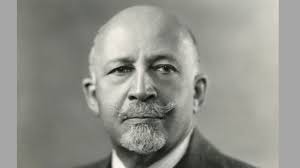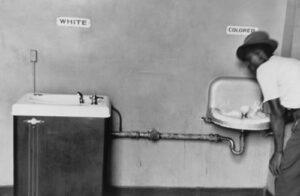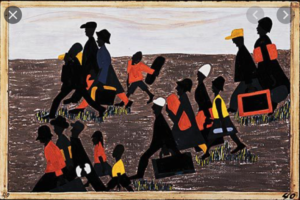For this project, I decided to talk about a significant historical figure who dedicated his life to his Black community. I will focus on W.E.B Du Bois and how he used his knowledge to get justice for his Balck community.

Who is William Edward Burghardt Du Bois?
There are many Black activists who used their knowledge to fight for equality and their rights in America. William Edward Burghardt Du Bois is a major Civil Rights Activist who was born on February 23, 1868, in Great Barrington, Massachusetts and died on August 27, 1963, in Accra, Ghana. He is an African American sociologist, writer, teacher, and leader who helped to change the way society viewed Blacks and their role. During the 19th century, many African Americans were not able to go to college and finish their education due to poverty, racism, and segregation. Unlike other African Americans, Du Bois grew up in Great Barrington which was a white town and there he went to school. He attended the same school as white kids. He did not face racism like other Blacks in different areas in the USA. Du Bois got enrolled at Fisk University in Nashville, Tennessee. Fisk University is a private college for African Americans that was established after the American Civil War to help African Americans finish their education. A church in his birth town (Barrington) raised money for him to pay for college tuition. There, Du Bois experienced his first southern segregation which motivated him to stand up for his Black community. He received his bachelor’s degree from Fisk University and later he was accepted to Harvard University. It was not an easy process for him to get accepted to Harvard University during the period of segregation. College tuition did not stop him from getting a higher degree in History and Sociology that would help him get justice for his Black community. He paid his three-year tuition with scholarships, loans from friends, and summer job money. In 1890, he earned his second bachelor’s degree and Master of Art in history from Harvard University. He traveled to Germany planning to get his Ph.D. He met significant social scientists who were thrilled to meet a man like him. Du Bois wanted to bring what he learned in Europe to the United States hoping to make a change. Unfortunately, he returned to the United States without his Ph.D. due to unknown reasons or requirements. However, two years later, he got his Ph.D. from Harvard University, while he was a professor at Wilberforce University. He was the first African American to earn a Ph.D. from Harvard University. This success does not only represent Du Bois but African Americans all over the United States. Despite all the obstacles that were established to prevent African Americans from succeeding, African Americans are proving their presence and importance in the USA. Du Bois’ educational journey explains how Blacks strove to overcome obstacles of racism and racial segregation.
How did W.E.B Du Bois view racism?
Racism is one of the first issues that challenged Blacks throughout United States history. Before the American Civil War, Blacks were treated as property due to their skin color. Because of and only of their skin color, they were not treated as human beings. The issue of racism is the issue that challenges Blacks regardless of the period of time. In “Of Du Bois and Diaspora: The Challenges of African American Studies”, Gomez analyzed Du Bois’ theory of double consciousness and how Blacks were deprived of their simplest wishes because of their identity. They were forced by society to view themselves through White’s perspective and Black perspective. Du Bois described this as Double Consciousness which is when a person has to view himself/ herself through two different perspectives. It was a must for them to view themselves through the white perspective because this is how society viewed them. Society viewed them with racism and as they are not part of this country. Du Bois believed Blacks would never give up on their identity to satisfy society. Their identity is part of their dream which is to be Black American in America. Du Bois Stated, “He would not bleach his Negro soul in a flood of White Americanism. . . He simply wishes to make it possible for a man to be both a Negro and an American, without being cursed and spit upon by his fellows, with-out the doors of Opportunity closed roughly” (Gomez 176). This illustrates Du Bois’ point of view on how racism affected Blacks in America. Du Bois described how Black natural identity deprived them of their simplest dream which is to be African American. However, Du Bois viewed racism as an obstacle that challenged Blacks and their dreams in America.
What is racial segregation (Jim Crow Laws)? What was Du Bois’ response?
Racial Segregation is one of the main issues African Americans have faced during the 19th-20th century. Blacks were segregated in schools, restaurants, trains, etc. Jim Crow law was to prevent African Americans from their constitutional rights which are equality. The photo illustrated below is one of the significant images in United States history that was taken during the Jim Crow Laws. If you take a closer look at the images, you will see how Blacks were treated by Segregation. The image is very clear in telling the story of segregation. Blacks had to drink from an old water fountain, while whites had to drink from a luxury water fountain, which emphasizes the racial inequality caused by Jim Crow laws. Therefore, this image invalidates the racial segregation statement of “separate but equal” because Blacks are being treated poorly compared to Whites.

By Elliot Erwitt in 1950 in North Carolina, USA.
However, Du Bois believed racial segregation would prevent Blacks from practicing their constitutional rights and them from progressing. He attacked Booker T Washington who is a Balck leader for accepting racial segregation. Du Bois and other activists gathered in 1905 at Niagara Falls to demand equality for Blacks and end racial segregation. The Niagra Movement is an organization of Blacks leaders and activists whose main mission is to end racial discrimination in all its aspects. They listed all their demands and their duties toward these demands. One of their demands that caught my attention in the Textbook “ Let Nobody Turn us Around” is “Soldiers: We regret that this nation has never seen fit adequately to reward the black soldiers who, in its five wars, have defended their country with their blood, and yet have been systematically denied the promotions which their abilities deserve. And we regard as unjust, the exclusion of black boys from the military and naval training schools’ ‘ (“The Niagara Movement Declaration of Principles”, p-211). This illustrates how blacks are giving up their lives for their country. They are loyal to the country that does not love them, to the country that does not treat them as human beings, and to the country that wounds them every day. Nevertheless, through the Nigro movement, Du Bois and other Blacks activists influenced the formation of the National Association for the Advancement of Colored People (NAACP). This association was formed by White and Black leaders which became the largest organization for civil rights. Through NAACP, Du Bois and other Black leaders were able to end racial segregation.
In conclusion, Du Bois is a significant Civil rights activist who fought racism and racial segregation with his knowledge. Du Bois wrote the “The Song of the Smoke”, which talks about how the Black community suffered racism, slavery, and racial segregation due to their natural identity. In this poetry, Du Bois stated, “Shedding the blood of bloodless crimes”, which emphasize African Americans’ pain of racism and racial segregation. However, Du Bois played a major role in America’s history. He stood up for the voiceless Black community and gave them a voice. He spent his life looking for a better life for the Black community. He overcame all the obstacles that were preventing him and his black community from practicing their constitutional right such as Jim Crow Laws. The Supreme Court ruled school segregation is unconstitutional which illustrates the progress Du Bois was made for the Black community. He was the leader of the NAACP that demanded equality for Blacks. Without Du Bois, blacks would not be where they are today.
Work Cited
History.com Editors. (2009, October 27). W.E.B. Du Bois. Retrieved December 16, 2020, from https://www.history.com/topics/black-history/w-e-b-du-bois
History.com Editors. (2018, February 28). Jim Crow Laws. Retrieved December 16, 2020, from https://www.history.com/topics/early-20th-century-us/jim-crow-laws
Trikha. (2012, November 06). Photographs that tell a story- Elliot Erwitt’s ‘Segregated Water Fountains’. Retrieved December 16, 2020, from https://sophiedaveyphoto.wordpress.com/2012/11/06/photographs-that-tell-a-story-elliot-erwitts-segregated-water-fountains/
W.E.B. Du Bois. (n.d.). Retrieved December 16, 2020, from https://www.crf-usa.org/black-history-month/w-e-b-du-bois
Gomez, Michael A. “Of Du Bois and Diaspora: The Challenge of African American Studies.” Journal of Black Studies, vol. 35, no. 2, 2004, pp. 175–194. JSTOR, www.jstor.org/stable/4129300. Accessed 16 Dec. 2020.
The Song of the Smoke. (2014, December 18). Retrieved December 16, 2020, from https://youtu.be/lzdXw8qbWpI
Marable, M., & Mullings, L. (2009). Let nobody turn us around: Voices of resistance, reform, and renewal: An African American anthology. Lanham: Rowman & Littlefield.






